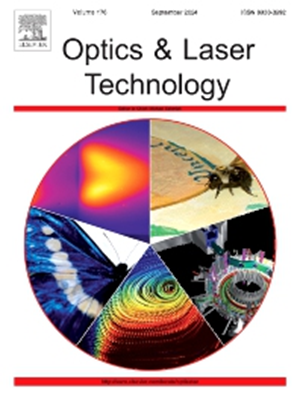Laser surface texture for enhancement of tribological performance of AISI 5115 steel engine valve train components
IF 4.6
2区 物理与天体物理
Q1 OPTICS
引用次数: 0
Abstract
Surface texturing is a promising technique for enhancing the tribological properties of contact surfaces. This study investigates the influence of texture geometry, orientation, and density on tribological efficiency under specific operating load and lubrication conditions. To improve the friction and wear properties of AISI 5115 steel, the surface was textured using a femtosecond fiber laser with three different geometries (triangle, ellipse, and circle) and four densities (5 %, 10 %, 15 %, and 20 %) in their correlation to reduce wettability contact angle to make surface super-oleophilic. The tribological performance of the textured surfaces was evaluated in dry, starved, and lubricated conditions at 100 RPM, 200 RPM, and 400 RPM using a pin-on-disc tribometer. Wear morphology and 3D surface roughness were analyzed using scanning electron microscopy (SEM) and laser scanning confocal microscopy (LSCM). A comparative analysis based on wear and the coefficient of friction (COF) for various geometries and densities was conducted, providing insights into the optimization of surface texturing for enhanced tribological performance. Compared to the untextured surface, 15 % ellipse texture with an aspect ratio of 0.1 incline at an angle of 45° have reduced COF by 18.8 %, 72.2 %, and 72 % for dry, staved, and lubricated conditions respectively. Similarly, 15 % ellipse texture has reduced wear by 93.2 %, 78.9 %, and 55.5 % in dry, starved, and lubricated conditions, respectively, in comparison to the untextured surface.
激光表面织构提高aisi5115钢发动机气门机构部件的摩擦学性能
表面织构是一种很有前途的提高接触面摩擦学性能的技术。在特定的工作载荷和润滑条件下,研究了织构几何、取向和密度对摩擦效率的影响。为了提高AISI 5115钢的摩擦磨损性能,采用飞秒光纤激光对其表面进行了三种不同几何形状(三角形、椭圆形和圆形)和四种密度(5%、10%、15%和20%)的织化,以降低润湿性接触角,使其表面具有超亲油性。在100rpm、200rpm和400rpm的干燥、饥饿和润滑条件下,使用针盘式摩擦计评估了纹理表面的摩擦学性能。利用扫描电子显微镜(SEM)和激光扫描共聚焦显微镜(LSCM)分析磨损形貌和三维表面粗糙度。针对不同的几何形状和密度,进行了基于磨损和摩擦系数(COF)的对比分析,为优化表面纹理以提高摩擦学性能提供了见解。与未加纹理的表面相比,15%的椭圆纹理(宽高比为0.1,倾角为45°)在干燥、铺板和润滑条件下的COF分别降低了18.8%、72.2%和72%。同样,15%的椭圆纹理在干燥、饥饿和润滑条件下,与没有纹理的表面相比,分别减少了93.2%、78.9%和55.5%的磨损。
本文章由计算机程序翻译,如有差异,请以英文原文为准。
求助全文
约1分钟内获得全文
求助全文
来源期刊
CiteScore
8.50
自引率
10.00%
发文量
1060
审稿时长
3.4 months
期刊介绍:
Optics & Laser Technology aims to provide a vehicle for the publication of a broad range of high quality research and review papers in those fields of scientific and engineering research appertaining to the development and application of the technology of optics and lasers. Papers describing original work in these areas are submitted to rigorous refereeing prior to acceptance for publication.
The scope of Optics & Laser Technology encompasses, but is not restricted to, the following areas:
•development in all types of lasers
•developments in optoelectronic devices and photonics
•developments in new photonics and optical concepts
•developments in conventional optics, optical instruments and components
•techniques of optical metrology, including interferometry and optical fibre sensors
•LIDAR and other non-contact optical measurement techniques, including optical methods in heat and fluid flow
•applications of lasers to materials processing, optical NDT display (including holography) and optical communication
•research and development in the field of laser safety including studies of hazards resulting from the applications of lasers (laser safety, hazards of laser fume)
•developments in optical computing and optical information processing
•developments in new optical materials
•developments in new optical characterization methods and techniques
•developments in quantum optics
•developments in light assisted micro and nanofabrication methods and techniques
•developments in nanophotonics and biophotonics
•developments in imaging processing and systems

 求助内容:
求助内容: 应助结果提醒方式:
应助结果提醒方式:


